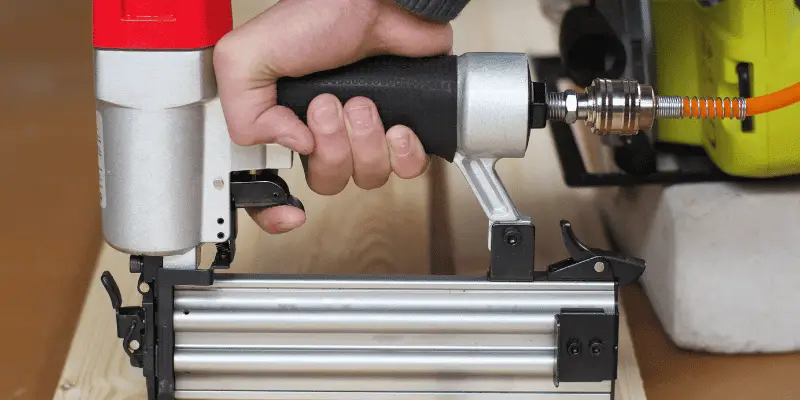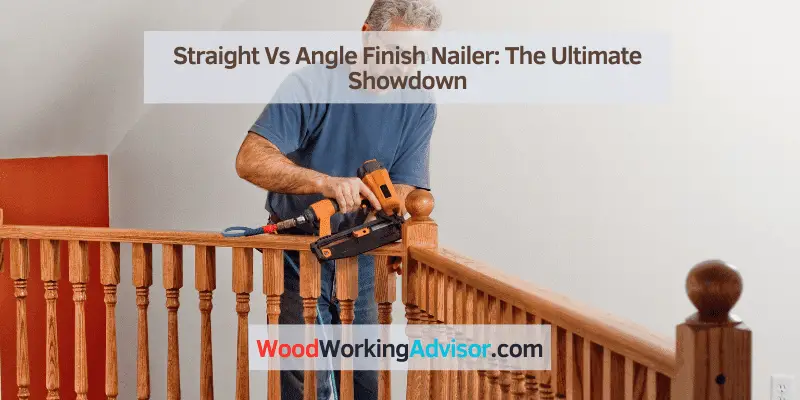A straight finish nailer drives nails straight into wood, while an angled finish nailer allows for more flexibility in tight spaces. When choosing between the two, consider the types of projects and spaces you will be working with, as well as your own preferences for maneuverability and ease of use.
Both types of nailers have their own advantages and drawbacks, and understanding the differences between them is essential for making an informed decision. We will explore the key features and uses of straight and angled finish nailers, helping you determine which type is best suited for your specific woodworking needs.
Understanding The Basics
When it comes to woodworking and carpentry, selecting the right finish nailer for your project is crucial. Understanding the basics of straight versus angle finish nailers can help you make an informed decision based on your specific needs and preferences.
Differentiating Straight And Angle Finish Nailers
Before delving into the nuances of each type, it’s essential to differentiate between straight and angle finish nailers. Straight finish nailers are designed to drive nails straight into a surface, making them ideal for tasks that require precision and a seamless finish. On the other hand, angle finish nailers are equipped with a magazine that holds nails at an angle, allowing for easier access to tight corners and confined spaces.
Application And Use Cases
The application and use cases of straight and angle finish nailers largely depend on the nature of the project. Straight finish nailers are commonly utilized for tasks such as baseboards, crown molding, and trim work where a flush and seamless finish is essential. Conversely, angle finish nailers are well-suited for applications in tight spaces, overhead installations, and intricate woodworking projects where maneuverability is crucial.
Pros And Cons Of Each Type
| Straight Finish Nailer | Angle Finish Nailer |
|---|---|
|
|
|
|
Performance And Precision
When it comes to selecting the right nailer for your woodworking and carpentry projects, the choice between a straight finish nailer and an angled finish nailer can make a significant impact on the performance and precision of your work. Let’s delve into the factors that contribute to the performance and precision of these nailers and their impact on woodworking and carpentry projects.
Focusing On Nail Placement Accuracy
Nail placement accuracy is crucial in ensuring the structural integrity and aesthetic appeal of woodworking and carpentry projects. Both straight and angled finish nailers offer precision in nail placement, but their design and angle of nail entry can affect the accuracy of nail placement in different scenarios. The angle of entry in an angled finish nailer allows for better access to tight corners and awkward angles, enabling precise placement in hard-to-reach areas. On the other hand, a straight finish nailer provides straightforward alignment for accurate nail placement on flat surfaces.
Impact On Woodworking And Carpentry Projects
The choice between a straight and angled finish nailer can greatly impact the efficiency and quality of woodworking and carpentry projects. An angled finish nailer excels in applications where access is limited, such as crown molding, baseboards, and trim work, thanks to its ability to reach confined spaces with ease. Conversely, a straight finish nailer is ideal for work on larger, open surfaces, offering quick and precise nail placement without the need to maneuver around obstacles. Each nailer performs best in specific project scenarios, and understanding their impact is essential in achieving optimal results in woodworking and carpentry.

Effect On Finishing Quality And Aesthetics
Besides performance, both straight and angled finish nailers have a distinct effect on the finishing quality and aesthetics of woodworking and carpentry projects. The angle at which nails are driven into the material can influence the overall appearance and durability of the finished product. Angled finish nailers offer a seamless finish with minimal visible nail holes, enhancing the aesthetic appeal of the project. Meanwhile, straight finish nailers provide a more traditional look with consistent nail alignment, making them suitable for projects where visible nail patterns are desirable.
Maneuverability And Versatility
When it comes to selecting the right nailer for your project, maneuverability and versatility are key factors to consider. Both straight and angled finish nailers offer unique benefits in this regard, making it crucial to understand the differences in handling and adaptability. Let’s delve deeper into how each type of nailer excels in maneuverability and versatility.
Handling In Tight And Awkward Spaces
The ability to navigate tight and awkward spaces is essential in many carpentry and woodworking projects. Straight finish nailers typically have a longer and bulkier design, making them more challenging to maneuver in confined areas. On the other hand, angle finish nailers, with their compact and angled magazine design, offer greater agility when working in tight corners or overhead positions.
Adaptability For Various Angles And Orientations
When it comes to adapting to different angles and orientations, the angle finish nailer shines. Its angled magazine allows for effortless fastening at varying angles, including those that are difficult to reach with a straight finish nailer. Whether you need to secure trim at a specific angle or navigate around obstacles, the angle finish nailer proves to be highly adaptable, offering increased precision and efficiency.
Durability And Maintenance
When comparing durability and maintenance of straight and angle finish nailers, it’s essential to note the differences in their design and usage. While both types have their advantages, the angle finish nailer’s angled magazine provides better access in tight spaces, making it more versatile for different projects.
However, the straight finish nailer is generally easier to maintain due to its simpler design and fewer moving parts.
Long-term Reliability And Wear And Tear
Straight and angle finish nailers differ in their construction, which impacts their long-term reliability. Straight finish nailers feature a more straightforward design, typically resulting in fewer moving parts and potential points of failure. On the other hand, angle finish nailers come with a more complex internal structure due to their angled magazine. This complexity might lead to higher wear and tear over time, affecting the tool’s long-term reliability.
Ease Of Cleaning And Upkeep
When it comes to maintenance, the ease of cleaning and upkeep differs between straight and angle finish nailers. Straight finish nailers often have simpler designs, making them easier to clean and maintain. Conversely, angle finish nailers with their intricate angle magazine might require more attention and precision when cleaning and servicing. This distinction impacts the overall maintenance requirements and upkeep of both types of nailers.
Implications For Total Cost Of Ownership
The differences in durability and maintenance between straight and angle finish nailers directly affect their total cost of ownership. Due to their simpler design and potentially lower wear and tear, straight finish nailers may incur lower maintenance costs over their lifespan. Additionally, the ease of cleaning and upkeep can result in reduced downtime and associated costs. On the other hand, the more complex construction of angle finish nailers might lead to higher maintenance expenses, impacting the overall total cost of ownership.
In conclusion, when deciding between a straight and angle finish nailer, assessing the long-term reliability, wear and tear, ease of cleaning, and implications for total cost of ownership is essential for making an informed choice.
User Experience And Ergonomics
When it comes to choosing between a straight and angle finish nailer, user experience and ergonomics play a crucial role in determining which tool is the best fit for your needs. Both comfort and control during extended use, as well as the impact on user fatigue and productivity, are key considerations that vary between the two nailer types. Additionally, different skill levels and preferences can also influence the choice between straight and angle finish nailers.
Comfort And Control During Extended Use
Comfort and control are essential factors to consider, especially if you anticipate using a finish nailer for extended periods. Straight finish nailers typically offer a more balanced and ergonomic grip due to the inline design, allowing for more precise and controlled maneuverability in tight spaces. On the other hand, angle finish nailers may provide better access to difficult angles because of their angled design, but could be less comfortable for prolonged use, particularly when operating overhead or in confined areas.
Impact On User Fatigue And Productivity
When comparing straight versus angle finish nailers, it’s crucial to assess the impact on user fatigue and productivity. The ergonomic handle and weight distribution of a straight finish nailer can help reduce strain on the user, promoting longer periods of comfortable usage and ultimately enhancing productivity. Conversely, while an angle finish nailer may offer advantages in terms of accessibility to tight spots, the angled form factor can lead to increased fatigue over extended use, potentially affecting overall productivity.
Considerations For Different Skill Levels And Preferences
Skill levels and individual preferences can significantly influence the choice between a straight and angle finish nailer. For novice users or those who prioritize ease of handling and maneuverability, a straight finish nailer might be the preferred option due to its user-friendly design and balanced grip. In contrast, experienced users who are accustomed to working in challenging angles may find an angle finish nailer to be a more suitable choice, considering its enhanced access to confined spaces.
Frequently Asked Questions On Straight Vs Angle Finish Nailer
What Is The Difference Between Straight And Angle Finish Nailer?
Straight finish nailers shoot nails straight, while angle finish nailers shoot nails at an angle. Straight nailers offer better precision, while angled nailers are more versatile in tight spots.
What Type Of Projects Are Best Suited For A Straight Finish Nailer?
Straight finish nailers are ideal for high precision projects like crown molding, baseboards, and furniture making where accuracy is crucial.
When Should I Use An Angle Finish Nailer Instead Of A Straight Finish Nailer?
Angle finish nailers are better for working in tight or awkward spaces where a straight finish nailer cannot effectively reach.
Can I Use The Same Nails For Both Straight And Angle Finish Nailers?
Yes, the nails used for straight and angle finish nailers are typically the same, but the angle finish nailer can also use nails with a slight angle.
Conclusion
In evaluating straight vs angle finish nailers, it’s clear that each has its own strengths and weaknesses. While straight nailers offer precision and ease of access, angle nailers provide accessibility in tight corners. Ultimately, the choice between the two will depend on the specific project requirements and the user’s preferences.
Both options offer unique benefits, and understanding their differences can significantly impact the quality of your work.


